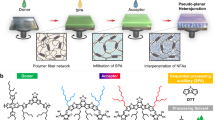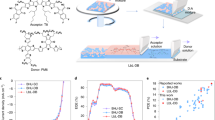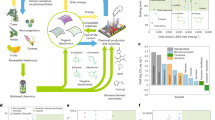Abstract
Organic solar cells have desirable properties, including low cost of materials, high-throughput roll-to-roll production, mechanical flexibility and light weight. However, all top-performance devices are at present processed using halogenated solvents, which are environmentally hazardous and would thus require expensive mitigation to contain the hazards. Attempts to process organic solar cells from non-halogenated solvents lead to inferior performance. Overcoming this hurdle, here we present a hydrocarbon-based processing system that is not only more environmentally friendly but also yields cells with power conversion efficiencies of up to 11.7%. Our processing system incorporates the synergistic effects of a hydrocarbon solvent, a novel additive, a suitable choice of polymer side chain, and strong temperature-dependent aggregation of the donor polymer. Our results not only demonstrate a method of producing active layers of organic solar cells in an environmentally friendly way, but also provide important scientific insights that will facilitate further improvement of the morphology and performance of organic solar cells.
This is a preview of subscription content, access via your institution
Access options
Subscribe to this journal
Receive 12 digital issues and online access to articles
$119.00 per year
only $9.92 per issue
Buy this article
- Purchase on Springer Link
- Instant access to full article PDF
Prices may be subject to local taxes which are calculated during checkout



Similar content being viewed by others
References
Yu, G., Gao, J., Hummelen, J. C., Wudl, F. & Heeger, A. J. Polymer photovoltaic cells-enhanced efficiencies via a network of internal donor–acceptor heterojunctions. Science 270, 1789–1791 (1995).
Li, G. et al. High-efficiency solution processable polymer photovoltaic cells by self-organization of polymer blends. Nature Mater. 4, 864–868 (2005).
Kim, J. Y. et al. Efficient tandem polymer solar cells fabricated by all-solution processing. Science 317, 222–225 (2007).
Peet, J. et al. Efficiency enhancement in low-bandgap polymer solar cells by processing with alkane dithiols. Nature Mater. 6, 497–500 (2007).
Chen, H.-Y. et al. Polymer solar cells with enhanced open-circuit voltage and efficiency. Nature Photon. 3, 649–653 (2009).
Park, S. H. et al. Bulk heterojunction solar cells with internal quantum efficiency approaching 100%. Nature Photon. 3, 297–302 (2009).
He, Z. et al. Enhanced power-conversion efficiency in polymer solar cells using an inverted device structure. Nature Photon. 6, 591–595 (2012).
Guo, X. et al. Polymer solar cells with enhanced fill factors. Nature Photon. 7, 825–833 (2013).
Heeger, A. J. 25th anniversary article: bulk heterojunction solar cells: understanding the mechanism of operation. Adv. Mater. 26, 10–28 (2014).
Liu, Y. et al. Aggregation and morphology control enables multiple cases of high-efficiency polymer solar cells. Nature Commun. 5, 5293 (2014).
He, Z. et al. Single-junction polymer solar cells with high efficiency and photovoltage. Nature Photon. 9, 174–179 (2015).
You, J. et al. A polymer tandem solar cell with 10.6% power conversion efficiency. Nature Commun. 4, 1446 (2013).
Zhou, H. et al. Polymer homo-tandem solar cells with best efficiency of 11.3%. Adv. Mater. 27, 1767–1773 (2015).
Yusoff, A. R. b. M. et al. A high efficiency solution processed polymer inverted triple-junction solar cell exhibiting a power conversion efficiency of 11.83%. Energy Environ. Sci. 8, 303–316 (2015).
Shaheen, S. E. et al. 2.5% efficient organic plastic solar cells. Appl. Phys. Lett. 78, 841–843 (2001).
Chueh, C.-C. et al. Non-halogenated solvents for environmentally friendly processing of high-performance bulk-heterojunction polymer solar cells. Energy Environ. Sci. 6, 3241–3248 (2013).
Chen, X., Liu, X., Burgers, M. A., Huang, Y. & Bazan, G. C. Green-solvent-processed molecular solar cells. Angew. Chem. Int. Ed. 53, 14378–14381 (2014).
Guo, X., Zhang, M., Cui, C., Hou, J. & Li, Y. Efficient polymer solar cells based on poly(3-hexylthiophene) and indene–C60 bisadduct fabricated with non-halogenated solvents. ACS Appl. Mater. Interfaces 6, 8190–8198 (2014).
Synooka, O., Eberhardt, K. R. & Hoppe, H. Chlorine-free processed high performance organic solar cells. RSC Adv. 4, 16681–16685 (2014).
Deng, Y. et al. Low bandgap conjugated polymers based on mono-fluorinated isoindigo for efficient bulk heterojunction polymer solar cells processed with non-chlorinated solvents. Energy Environ. Sci. 8, 585–591 (2015).
Sprau, C. et al. Highly efficient polymer solar cells cast from non-halogenated xylene/anisaldehyde solution. Energy Environ. Sci. 8, 2744–2752 (2015).
Zhao, W., Ye, L., Zhang, S., Sun, M. & Hou, J. A universal halogen-free solvent system for highly efficient polymer solar cells. J. Mater. Chem. A 3, 12723–12729 (2015).
Huang, Y., Kramer, E. J., Heeger, A. J. & Bazan, G. C. Bulk heterojunction solar cells: morphology and performance relationships. Chem. Rev. 114, 7006–7043 (2014).
Scrivens, W. A. & Tour, J. M. Potent solvents for C60 and their utility for the rapid acquisition of 13C NMR data for fullerenes. J. Chem. Soc. Chem. Commun. 1207–1209 (1993).
Lee, J. K. et al. Processing additives for improved efficiency from bulk heterojunction solar cells. J. Am. Chem. Soc. 130, 3619–3623 (2008).
Ruoff, R. S., Tse, D. S., Malhotra, R. & Lorents, D. C. Solubility of fullerene (C60) in a variety of solvents. J. Phys. Chem. 97, 3379–3383 (1993).
Swaraj, S. et al. Nanomorphology of bulk heterojunction photovoltaic thin films probed with resonant soft X-ray scattering. Nano Lett. 10, 2863–2869 (2010).
Collins, B. A. et al. Absolute measurement of domain composition and nanoscale size distribution explains performance in PTB7:PC71BM solar cells. Adv. Energy Mater. 3, 65–74 (2013).
Chen, W. et al. Hierarchical nanomorphologies promote exciton dissociation in polymer/fullerene bulk heterojunction solar cells. Nano Lett. 11, 3707–3713 (2011).
Shaw, P. E., Ruseckas, A. & Samuel, I. D. W. Exciton diffusion measurements in poly(3-hexylthiophene). Adv. Mater. 20, 3516–3520 (2008).
Stuart, A. C. et al. Fluorine substituents reduce charge recombination and drive structure and morphology development in polymer solar cells. J. Am. Chem. Soc. 135, 1806–1815 (2013).
Albrecht, S. et al. Quantifying charge extraction in organic solar cells: the case of fluorinated PCPDTBT. J. Phys. Chem. Lett. 5, 1131–1138 (2014).
Ma, W. et al. Domain purity, miscibility, and molecular orientation at donor/acceptor interfaces in high performance organic solar cells: paths to further improvement. Adv. Energy Mater. 3, 864–872 (2013).
Mukherjee, S. et al. Importance of domain purity and molecular packing in efficient solution-processed small-molecule solar cells. Adv. Mater. 27, 1105–1111 (2015).
Collins, B. A. et al. Polarized X-ray scattering reveals non-crystalline orientational ordering in organic films. Nature Mater. 11, 536–543 (2012).
Tumbleston, J. R. et al. The influence of molecular orientation on organic bulk heterojunction solar cells. Nature Photon. 8, 385–391 (2014).
Li, Z. et al. Dramatic performance enhancement for large bandgap thick-film polymer solar cells introduced by a difluorinated donor unit. Nano Energy 15, 607–615 (2015).
Ouyang, X., Peng, R., Ai, L., Zhang, X. & Ge, Z. Efficient polymer solar cells employing a non-conjugated small-molecule electrolyte. Nature Photon. 9, 520–524 (2015).
Lu, L., Xu, T., Chen, W., Landry, E. S. & Yu, L. Ternary blend polymer solar cells with enhanced power conversion efficiency. Nature Photon. 8, 716–722 (2014).
Nian, L. et al. Photoconductive cathode interlayer for highly efficient inverted polymer solar cells. J. Am. Chem. Soc. 137, 6995–6998 (2015).
Liao, S.-H. et al. Single junction inverted polymer solar cell reaching power conversion efficiency 10.31% by employing dual-doped zinc oxide nano-film as cathode interlayer. Sci. Rep. 4, 6813 (2014).
Hexemer, A. et al. A SAXS/WAXS/GISAXS beamline with multilayer monochromator. J. Phys. Conf. Ser. 247, 012007 (2010).
Rivnay, J., Noriega, R., Kline, R. J., Salleo, A. & Toney, M. F. Quantitative analysis of lattice disorder and crystallite size in organic semiconductor thin films. Phys. Rev. B 84, 045203 (2011).
Gann, E. et al. Soft X-ray scattering facility at the Advanced Light Source with real-time data processing and analysis. Rev. Sci. Instrum. 83, 045110 (2012).
Acknowledgements
The work was partially supported by the National Basic Research Program of China (973 Program; 2013CB834705), HK JEBN Limited (Hong Kong), the Hong Kong Research Grants Council (T23–407/13-N, N_HKUST623/13, and 606012), HKUST President’s Office through SSTSP scheme (project ref number: EP201) and the National Natural Science Foundation of China (NSFC, #21374090, 21504066, 21534003 and 51320105014). We thank Enli Technology Co., Ltd (Taiwan) for carrying out EQE measurements and Raynergy Tek Incorporation (Taiwan) for providing building blocks. H.A. is supported by ONR grants N000141410531 and N00141512322. X-ray data was acquired at beamlines 11.0.1.2 and 7.3.3 at the Advanced Light Source, which is supported by the Director, Office of Science, Office of Basic Energy Sciences, of the US Department of Energy under Contract No. DE-AC02-05CH11231.
Author information
Authors and Affiliations
Contributions
J.Z. selected the solvent/additive and synthesized PffBT4T-C9C13; Y.L. fabricated and optimized the devices; Y.L. prepared the devices for certification and samples for X-ray characterization; W.M. collected the X-ray data; G.Y. analysed the X-ray data supervised by W.M.; K.J. fabricated and optimized the devices based on PTB7 and PffBT4T-C8C12; H.L. synthesized PffT2-FTAZ-C10C14; J.Z., H.Y., W.M. and H.A. integrated the interpretation and drafted the paper; H.Y. conceived and directed the project; all authors commented on the final paper.
Corresponding authors
Ethics declarations
Competing interests
The authors declare no competing financial interests.
Supplementary information
Supplementary Information
Supplementary Tables 1-5, Supplementary Figures 1-42, Supplementary Note, Supplementary Methods, Supplementary References. (PDF 3280 kb)
Rights and permissions
About this article
Cite this article
Zhao, J., Li, Y., Yang, G. et al. Efficient organic solar cells processed from hydrocarbon solvents. Nat Energy 1, 15027 (2016). https://doi.org/10.1038/nenergy.2015.27
Received:
Accepted:
Published:
DOI: https://doi.org/10.1038/nenergy.2015.27
This article is cited by
-
Correlating the structures and photovoltaic properties in phase-separated blends of conjugated donor polymers and acceptors
Polymer Journal (2023)
-
Synthesis and solar cell applications of semiconducting polymers based on vinylene-bridged 5-alkoxy-6-fluorobenzo[c][1,2,5]thiadiazole (FOBTzE)
Polymer Journal (2023)
-
A materials physics perspective on structure–processing–function relations in blends of organic semiconductors
Nature Reviews Materials (2023)
-
Volatile and non-volatile additives for Polymer Solar cells from Fullerene to non-fullerene systems
Journal of Polymer Research (2023)
-
The role of domain size and weight ratio of fullerene and non-fullerene acceptors on performance of PM6:Y6: PCBM ternary solar cell
Optical and Quantum Electronics (2023)



